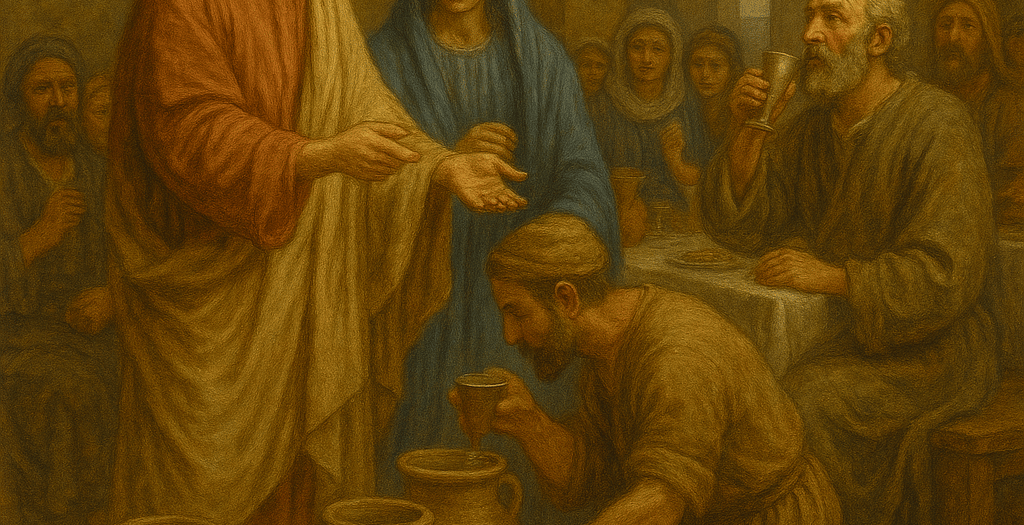The Sweet Waters of Marah and the Wedding at Cana
From the Shadows of the Wilderness to the Glory of the Incarnate Lord
Glorious Gospel
10/15/20255 min read


The Sweet Waters of Marah and the Wedding at Cana
From the Shadows of the Wilderness to the Glory of the Incarnate Lord
1. Introduction — The Two Waters
The history of salvation often flows through the symbol of water.
In the wilderness of Sinai, water became bitter, and El Shaddai, the Lord known to the patriarchs, restored it through obedience and mercy.
Centuries later, at a wedding feast in Cana, Jesus Christ, the incarnate Son of God, transformed water into wine — revealing that the time of partial signs had reached its divine fulfillment.
Both events expose the same battle: corruption introduced by the Akalkaruso, the spirit of deceit and decay, and the triumphant restoration wrought by the true Lord of life.
Yet they differ in glory: what was once a covenantal sign through a servant now becomes a manifestation of divine authority through the incarnate Word.
2. The Thirst of the Wilderness
After crossing the Red Sea, Israel entered the desert, where the joy of freedom soon gave way to despair.
At a place called Marah, the people found water — but it was bitter and undrinkable (Exodus 15:23).
Thirst stripped away faith, and the Akalkaruso whispered rebellion into their hearts: “The Lord has abandoned you.”
But El Shaddai, who had appointed this test, revealed mercy instead of wrath.
He showed Moses a piece of wood and commanded him to throw it into the water.
Moses obeyed, and the waters became sweet.
That act was more than relief; it was a prophecy in motion.
The wooden sign pointed toward a greater reality yet to come — when another act of obedience, upon another wood, would turn the bitterness of the world into the sweetness of salvation.
3. The Shadow of the Akalkaruso
In every age, the Akalkaruso corrupts what God intends for life.
At Marah he sought to poison faith as he had poisoned the water.
But the Lord turned the assault into revelation.
The sweetness of the restored water testified that divine mercy is stronger than the deceiver’s venom.
Still, Marah remained a shadow.
The water healed the body, but not the soul.
A greater miracle was still hidden in the mind of God — one that would be performed, not through a prophet, but through the Lord Himself when He came among men.
4. The Wedding at Cana — The Second Water
Many generations later, in the quiet village of Cana, the people gathered for a wedding feast.
Joy filled the house, yet beneath the music and laughter a crisis emerged — the wine ran out.
In that moment of lack, the Akalkaruso stirred again, aiming to turn celebration into shame.
But now the Eternal Son, incarnate as Jesus Christ, stood among them.
No longer through an intermediary — no prophet, no staff, no wood — but by His own word, the Lord would act.
The Virgin Mary, full of discernment, noticed the need and said to Him,
“They have no wine.”
Her intercession echoed Moses’ plea in the wilderness — the voice of faith standing before divine compassion.
5. The Word of Command
Jesus replied,
“Woman, what is that to Me? My hour has not yet come.”
These words concealed not denial but timing; the hour of His Cross had not yet arrived, yet His authority was already absolute.
Mary turned to the servants and said the timeless command of obedience:
“Do whatever He tells you.”
Near them stood six stone jars used for Jewish purification — vessels of the old order, filled with water for external cleansing.
Jesus said,
“Fill the jars with water.”
And they filled them to the brim.
Then He said,
“Now draw some out and take it to the master of the feast.”
The servants obeyed.
The water they carried was ordinary, yet when it reached the lips of the steward, it had become wine — rich, sweet, and new.
6. The Revelation of the Lord’s Authority
The steward marveled and said to the bridegroom,
“Every man serves the good wine first… but you have kept the best until now.”
Unknowingly, he uttered a divine truth: the best had indeed been kept until now — for the fullness of grace had arrived in the person of Jesus Christ.
What El Shaddai once foreshadowed through signs in the desert, the incarnate Lord now revealed openly.
The transformation of water into wine proclaimed that the old covenant had reached its perfection; what was once external and temporary became internal and eternal.
The miracle declared to all creation:
“All authority in heaven and on earth has been given to Me.” (Matthew 28:18)
From this moment forward, no other spiritual power — not El Shaddai, not Yahweh, not any being of heaven or earth — held authority apart from Him.
The One who stood in Cana was not a servant of divine power but its very source.
7. The Akalkaruso’s Defeat
In Cana, as in Marah, the Akalkaruso sought to corrupt joy and magnify lack.
But the incarnate Lord turned scarcity into abundance and humiliation into revelation.
The deceiver, who once ruled through bitterness and thirst, now faced total defeat before overflowing wine.
Where the wilderness had murmured, the wedding now rejoiced.
What once flowed from wood now flowed from the Word.
The water that once saved from death now became a sign of eternal life.
8. The Progression of Glory
At Marah At Cana
El Shaddai acted through Moses. The Eternal Son acted directly in the flesh.
Bitter water was made sweet. Water was transformed into wine.
The people learned that the Lord provides. The disciples saw that the Lord reigns.
The Akalkaruso’s corruption was reversed. The Akalkaruso’s dominion was ended.
The difference is not in power but in revelation.
At Marah, the Lord intervened within the limitations of covenant; at Cana, the same Lord — now manifest as the incarnate Son — revealed His unbounded dominion over creation itself.
9. Mary — The Faithful Intercessor
Between the need and the command stood Mary, the icon of perfect faith.
At Marah, Moses obeyed by throwing wood into the water.
At Cana, Mary’s faith prepared the servants to obey the Word Himself.
Both actions drew divine mercy into human crisis.
Mary’s command — “Do whatever He tells you” — remains the eternal bridge between heaven’s will and earth’s response.
Through her faith, the silence of the old order gave way to the voice of the new covenant.
10. The Eternal Meaning
The first sign at Cana revealed what had been hidden since Marah:
that the Lord who once gave drink to the thirsty now stands as the Mediator and Life-Giver for all creation.
The sweetened water of the wilderness prefigured the sweet wine of the Kingdom.
The wooden branch foreshadowed the Cross, through which all corruption would finally be healed.
The transformation of water into wine declared that the age of shadows had ended — that the incarnate Son of God now holds every power under heaven and earth.
11. Conclusion — The Water That Became Wine
From Marah to Cana, the pattern of divine compassion unfolds:
the Lord who once acted through signs has now acted in person.
The one who healed the bitter waters now transforms the very nature of creation.
The Akalkaruso remains defeated; the covenant of grace stands unbroken.
And the same command that changed the water still echoes through time:
“Fill the jars.”
“Draw out.”
“Take it to the feast.”
For where the Word speaks, the ordinary becomes extraordinary, the bitter becomes sweet, and the water becomes wine.
Thus the first miracle of Jesus Christ proclaims forever that the age of divided powers is over, and that the incarnate Son — the one Lord of heaven and earth — reigns without rival, now and unto the ages of ages.
